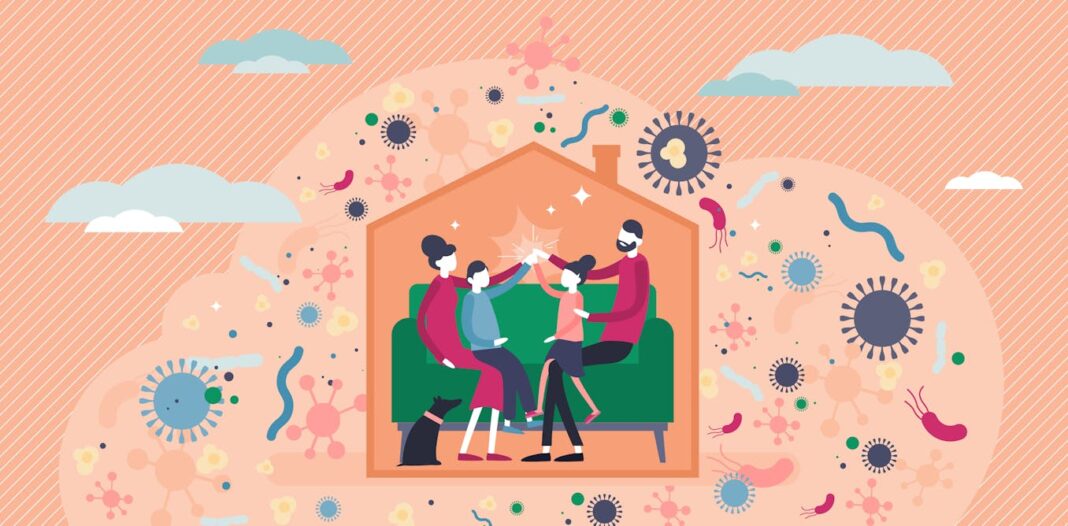We spend around 90% of our lives indoors. But what you might not realise while you’re cosied up at home is that you don’t just share your space with your family or pets – you also share it with millions of invisible microbes. In fact, house dust is home to 9,000 different species.
Just like our gut and mouth, our homes also have a microbiome. Known as the “indoor microbiome”this is the intricate ecosystem of bacteria, fungi, viruses and other microorganisms that thrive in the places we live, work and study.
As researchers delve deeper into the indoor microbiome, its significant impact on our health are becoming increasingly evident. Current research shows it may have an influence on everything from our respiratory health, how our immune system functions and even our mental wellbeing.
Microbial community
The indoor microbiome is significantly influenced by us. Cooking, cleaning and even having a pet shape the microbial populations in our home.
Interestingly, the design and operation of buildings also play crucial roles in determining which microbes thrive indoors. For example, the type of ventilation system in place, the presence of natural light and the construction materials used can either promote or inhibit the growth of certain microbes.
The indoor microbiome can influence our health in both positive and negative ways.
On the positive sideexposure to a diverse range of microbes can boost our immune system, especially during childhood. This idea is rooted in the hygiene hypothesiswhich suggests early exposure to microbes helps train the immune system to distinguish between harmful and harmless agents. This may reduce the likelihood of developing certain allergies and autoimmune diseases (such as asthma, hay fever, eczema and multiple sclerosis).
This microbial exposure may also bolster the immune system against common respiratory illnesses like colds, flu and bronchitis.
But exposure to certain microbes can also have negative consequences.
Yurii_Yarema/Shutterstock
Certain indoor environments – particularly those with poor ventilation and high levels of moisture – can harbour harmful pathogens. Damp and mouldy conditions, for instance, are associated with respiratory issues such as asthma and allergies. Poor ventilation may also allow common respiratory illnesses – such as COVID-19 – to spread more easily.
Furthermore, the use of antimicrobial cleaning products indoors may inadvertently make it easier for antibiotic-resistant bacteria to thrive – posing a significant public health risk. When bacteria are frequently exposed to antimicrobial cleaning products, they develop crafty mechanisms that help them survive and thrive even when these products are used in the future.
Beyond physical health, emerging evidence suggests the indoor microbiome could also influence mental health.
Urban living has been linked to an increased risk of mental health issues – such as depression. While there are probably many factors at play, this could be related to the gut-brain axis. This is the pathway the gut microbiome uses to communicates with the brain – which also influences mood and cognitive function.
People living in a city are exposed to fewer microbial species than those living in rural areas. This may cause us to have a less diverse gut microbiome in turn, which could disrupt the communication between our gut and brain – contributing to mental health disorders.
Creating healthier spaces
Given the influence of the indoor microbiome on our health, there’s growing interest in intentionally shaping these microbial communities to promote wellbeing.
For instance, buildings could be designed in such a way that they naturally support a healthy microbiome. This could be done by using natural materials – such as wood, which can harbour beneficial microbes – or by designing ventilation systems that enhance microbial diversity.
Other ways of designing “healthy buildings” to optimise the indoor microbiome could even feature living walls with diverse plant and microbial life, or using building materials embedded with beneficial bacterial spores that can be activated when needed. These innovations may help to minimise the number of harmful microbes while simultaneously exposing us to beneficial ones.
Another promising strategy is the use of probiotics – not just for our bodies, but for our buildings. Probiotic cleaning productswhich introduce beneficial microbes into the environment, are being explored as a way of out-competing harmful pathogens and promoting a healthier indoor microbiome.
Indoor plants can also contribute to a healthier microbial environment. Plants not only purify the air but also cultivate diverse microbial communities indoors.
The indoor microbiome is a crucial, though often overlooked, aspect of our living environment. As our understanding of the indoor microbiome deepens, the potential to design spaces that enhance our health becomes increasingly feasible. This knowledge could lead to a future where homes and workplaces are not just places of shelter but active contributors to our wellbeing.
The challenge now lies in making these advancements accessible to all – ensuring everyone can have a health indoor microbiome, regardless of their socioeconomic status.




